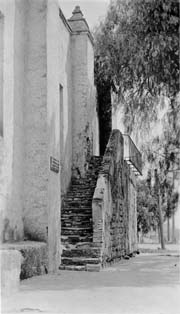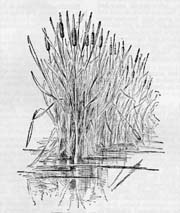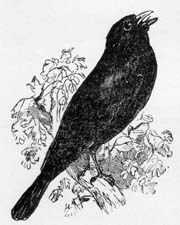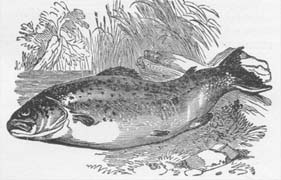 |
This is the stairway at
the San Gabriel Mission. |
Return to Echo Mtn. Echoes, Summer 1999 Cover
| Wild Foods of the Gabrielino |
By Christopher Nyerges
There is another story of an earlier day in the Pasadena area, before the parade floats, before the immigrants came and claimed the land. |
This is the stairway at
the San Gabriel Mission. |
Well before the Declaration of Independence was signed far to the east, the area that is now known as Pasadena, and most of Los Angeles County, was occupied by people who later came to be known as the Gabrielino Indians. The term "Gabrielino" came from the San Gabriel Mission, but the Indians themselves had their own local names. Those who lived in what became downtown L.A. were the Yangnas, on the west side were the Tongvas, up in the foothills were the Tujungnas, down by Long Beach were the Puvungnas, and greater Pasadena and the Arroyo Seco was occupied by the Hahamongna.
These people practiced no agriculture in the modern sense, and they domesticated no animals. So how did they survive? They gathered, hunted, and ate these local foods and animals.
Their method of healing was considered fairly advanced, and it included acknowledgment of the spirit world, and rattles, singing, chanting, ceremonies, and the use of steam baths and herbal teas.
Their numbers were relatively small, compared to the present-day population of Pasadena. And so while the prospect of Pasadena’s present population living off the wilds is somewhat bleak, you can still find most of the plants they used in the small pockets of wilderness that are still scattered around the San Gabriel Valley and the local mountains.
One of the main plant staples was the acorn, which falls in autumn from the oak trees. Acorns are bitter raw due to presence of tannic acid. There were several ways in which the acorns were rendered edible. One method was to shell them, and place them in a woven bag in the river. It would take anywhere from 24 hours to a week for the river water to wash out the tannic acid.
Another method used by the local people was to shell and grind the acorns, and then place the acorn meal into a hollowed-out section of the streambed, or into a shallow basket. Then hot water would be poured over the meal so the tannin would wash out. This would be repeated until the bitterness was gone. Then the meal, or "dough," would be collected, being careful to not mix sand with the meal. The dough would then be made into flat bread, used as a thickener for soups, or cooked into a mush-like soup or gruel.
Acorns would be stored, shelled or unshelled, to ensure a food supply for the year. For a family of five, a minimum of 500 pounds was considered a year’s supply.
Chia (Salvia columbariae), an annual member of the sage family, produced small brown seeds in its whorled seedpods. These seeds were roasted and ground into meal, and eaten once mixed with water. The seeds have a glutinous consistency, a high food value, and are easily digested.
The tender tops of white sage (Salvia apiana) were steamed and eaten, having a texture similar to cooked cabbage.
Both the young, succulent leaves and the sweet fruits of the prickly pear cactus (Opuntia sps.) were eaten. The seeds of the fruit were saved, ground, and made into meal.
A tender plant called Miner’s lettuce or Indian lettuce (Montia perfoliata) was also used in salad and stews. The plant is easily recognized by the circular, cup-shaped leaf out of which rises the flower stalk.
 |
Cat-Tail (Typha Latifolia). |
The young shoots of cattails, with their crisp cucumber-like flavor, were also used raw or in cooked dishes.
Yucca, which was the most important fibre plant for all the Southwestern Indians, was also a source of food. The ripe fruits were roasted or boiled, and allowed to sun dry. The dried fruit would be eaten as-is, or boiled, or mixed with other foods. The yucca flowers were also cooked and eaten. The very young flower spike, just as it begins to emerge in the spring, would be cut, baked, and would serve five or six people.
The Gabrielinos also put to good use the native wild berries. These included grapes, wild cherries, elderberries, blackberries, currants and gooseberries, manzanita berries (means "little apple" in Spanish), and the fully ripened Western black nightshade berries (toxic when green). Another commonly used fruit was the hollyleaf cherry (Prunus ilicifolia). The fruit is a large pit surrounded by a usually thin layer of
sweet pulp. The seeds would be shelled, ground, and leached as acorns to remove the bitterness, and then mixed into soups or breads.
In July 1769, Father Junipero Serra, writing of the Pasadena area, said that "We found vines, wild of a large size and in some cases quite loaded with grapes. We have seen Indians in immense numbers.... They continue to make a good subsistence from various seeds and by fishing." Wild oats and various other grasses were harvested for their grain.
The Gabrielinos also used the introduced watercress that eventually grew in every waterway. The watercress was common in the Arroyo Seco and would be used fresh or mixed with other greens.
They also used chili peppers, which were most likely from plants that the Spanish had introduced.
 |
Food of the Gabrielino included
Blackbird (Turdus Merula) |
Having eaten all the plants described, I can say that the diet of the early people of this area was not simply bland and bitter undesirable food. In fact, the scope of flavor from these wild foods would have certainly exceeded the flavors you find today in any supermarket. Plus, as any nutritional analysis shows, plants growing wild are nearly always far richer in necessary vitamins and minerals than the domestic foods from farms.
Animals foods of the Gabrielinos included deer, coyote, squirrels, badgers, rabbits, skunks, black birds, hawks, rats, gophers, and wild cats. Snakes were eaten but rattlesnakes were avoided, probably because of the danger of getting bit. Bears were common but not killed and eaten since it was believed that the soul of a wizard could enter animals, especially bears. Similar beliefs were associated with eagles, owls, and crows.
A favorite insect food was a large grasshopper roasted on a stick over a fire. Quail was once abundant in the Pasadena area, and alert hikers can still see some. A healthy quail lay about two dozen eggs a season, and these would be collected and used in the Gabrielino diet.
 |
Trout (Salmo fario) and other
fish were caught in the local waterways. Besides the methods of fishing most commonly
thought of the Gabrielino used plants to poison the fish which caused them to rise to the
top. |
Trout and other fish were caught in the local waterways. Fish would be speared, caught with nets, or poisoned with any of a few common fish-stupefying plants. Two such plants found locally are the nuts of the California buckeye (Aesculus californica) and the leaves of the fresh turkey mullein (Eremocarpus setigerus), also known as yerba del pescado by the Spanish. The crushed nuts or leaves would be tossed into a small pool where there was minimal water flow. Soon the fish would float to the top where they would be scooped out, cleaned, cooked, and eaten.
Jimsonweed (Datura meteloides), known as Qui-qui-sa-waal, was used carefully in certain ceremonies, and was also used for its reputed antivenin properties in cases of rattlesnake or toxic spider bites. Tree tobacco (Nicotiana glauca), known as Tee-baat, is a poisonous plant if eaten, and was used externally as a hot poultice for rheumatism or other pains.
The daily ways of survival by these geographic ancestors of ours has not been lost to history. Their descendants are still in our midst and there are occasional public gatherings where some of the old ways are taught and shared.
Beside the knowledge of food plants, the skills included making clothing, shelters, tools, weapons, weaving, as well as the unique values and beliefs that are often passed down through the generations.
The old ways are not dead. Their relevance to us today is great, as we in modern society are so connected and dependant on someone or something else that we have little knowledge of how to survive should our modern technologies ever fail us.
For more information, go to the Southwest Museum in Highland Park, the Pasadena Historical Society, or local bookstores where there are books about the Gabrielinos.
Return to Echo Mtn. Echoes, Summer 1999 CoverSince 1974, Nyerges has been conducting field trips to teach how to identify edible wild plants, and learn about the survival skills of the past. He is the author of Enter the Forest and Guide to Wild Foods, which contain information about the ways of the Gabrielinos in the past. Both books are available in the Echo Mtn. Echoe’s Mountain Marketplace. For a schedule of his classes, contact him at School of Self-Reliance, Box 41834, Eagle Rock, CA 90041, or on-line at www.self-reliance.net.
[ Issues | Search | Help | Subscribe | Comment | Websites ]
Send email to Echowebmaster@aaaim.com to report any problems.
Last modified: February 12, 1999
No part of this paper may be
reproduced in any form without written permission from:
Jake Brouwer
All articles and photos were provided by:
Land-Sea Discovery Group
Copyright © 1999